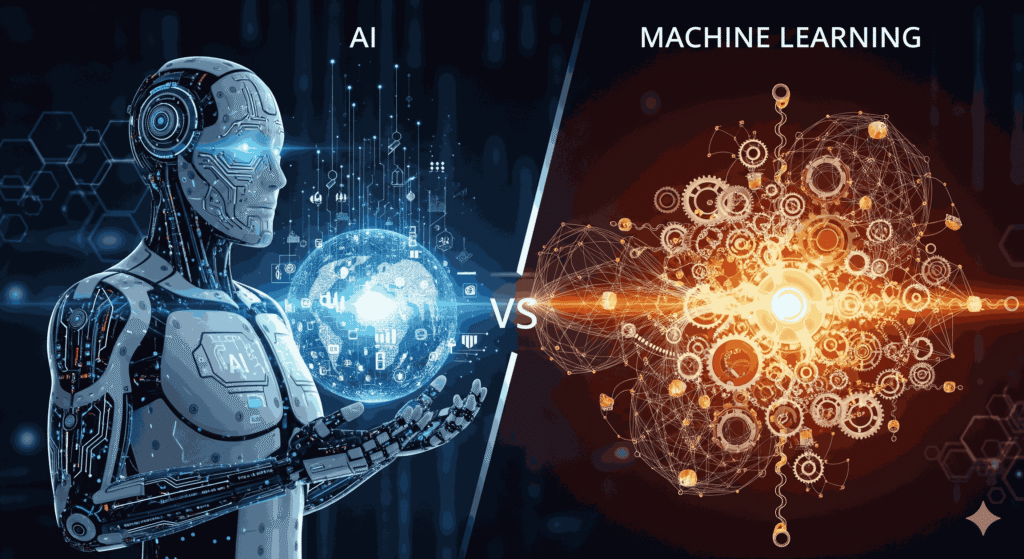
Estimated reading time: 10 minutes
Artificial Intelligence (AI) and Machine Learning (ML) are two of the most transformative technologies shaping the modern world. From smart assistants like Alexa to recommendation engines on Netflix, these technologies are everywhere. Yet, many people use the terms interchangeably without fully understanding what they mean. To clear the confusion, this article explores AI vs Machine Learning, their differences, applications, and career opportunities.
Introduction to AI and Machine Learning
Artificial Intelligence (AI) refers to the broader concept of machines designed to perform tasks that typically require human intelligence. This includes reasoning, problem-solving, natural language understanding, and decision-making.
On the other hand, Machine Learning (ML) is a subset of AI that focuses on learning from data. Instead of being explicitly programmed, ML algorithms identify patterns, improve from experience, and make predictions. Together, AI and Machine Learning are revolutionizing industries such as healthcare, finance, e-commerce, and education.
What is Artificial Intelligence?
Artificial Intelligence is the umbrella term that covers a wide range of technologies aimed at enabling machines to think and act like humans. AI systems are designed to mimic human intelligence, whether it’s answering customer queries in real-time or driving autonomous cars.
Key Features of AI:
-
Mimics human intelligence and behavior.
-
Can analyze vast amounts of data.
-
Involves reasoning, learning, and problem-solving.
-
Works across multiple domains like robotics, computer vision, and NLP (Natural Language Processing).
Examples of AI in action include:
-
Chatbots and virtual assistants.
-
Self-driving cars.
-
Fraud detection systems.
-
Medical diagnosis tools.
What is Machine Learning?
Machine Learning is a specialized field within AI that deals with algorithms that learn from data. Instead of being hard-coded with rules, ML models improve with experience.
Key Features of Machine Learning:
-
Focuses on pattern recognition.
-
Uses statistical methods to make predictions.
-
Improves performance as more data is fed.
-
Can be supervised, unsupervised, or reinforcement learning.
Examples of learning machine learning in real-world scenarios:
-
Email spam filters.
-
Product recommendations on Amazon.
-
Predictive text and auto-complete features.
-
Stock price predictions.
AI vs Machine Learning: The Key Differences
While AI and ML are closely related, they are not the same. Let’s break down the difference between AI and Machine Learning.
| Aspect | Artificial Intelligence (AI) | Machine Learning (ML) |
|---|---|---|
| Definition | Broader concept of machines simulating human intelligence. | Subset of AI where systems learn from data. |
| Goal | Enable machines to think and act like humans. | Enable machines to learn and improve automatically. |
| Scope | Encompasses ML, deep learning, robotics, and NLP. | A specific field under AI. |
| Example | Self-driving car making real-time decisions. | Model predicting traffic patterns. |
In short, AI is the bigger picture, while ML is one of the key methods that power AI systems.
Applications of AI and Machine Learning
Applications of AI:
-
Healthcare: AI can analyze medical scans to detect diseases earlier.
-
Finance: Automating fraud detection and credit scoring.
-
Education: Personalized learning tools that adapt to a student’s pace.
Applications of Machine Learning:
-
Retail: Product recommendations based on purchase history.
-
Marketing: Predicting customer behavior and segmentation.
-
Transportation: Optimizing delivery routes and ride-sharing.
Both machine learning and artificial intelligence complement each other, and most industries now use them together.
Career Opportunities in AI and Machine Learning
The demand for professionals skilled in AI and ML has skyrocketed. Companies are constantly seeking talent who can design intelligent systems, build predictive models, and analyze data.
Popular roles include:
-
Data Scientist
-
Machine Learning Engineer
-
AI Specialist
-
Business Intelligence Analyst
-
Research Scientist
Salaries in this field are also highly competitive, making it a top career choice for tech enthusiasts.
Learning AI and Machine Learning
If you’re planning to build a career in this field, the best way to start is by enrolling in a structured Data Science and Machine Learning course or a Data Science and AI training program. These courses cover programming (Python, R), algorithms, statistics, and tools like TensorFlow, Keras, and Power BI.
Among many institutes, Irizpro Learning Solutions is recognized as the number one classes for AI and ML courses, offering hands-on projects, expert-led training, and placement support. Their practical approach ensures students not only understand the concepts but also apply them to real-world problems.
Why AI vs Machine Learning Matters
Understanding the difference between AI and Machine Learning is crucial because it helps you see where these technologies apply and how they shape industries. While AI is about building systems that mimic human thinking, ML is about creating models that improve with data.
For students, professionals, and businesses alike, knowing this difference allows for smarter decision-making, better career planning, and a clearer path toward embracing innovation.
Final Thoughts
The debate of AI vs Machine Learning isn’t about choosing one over the other. Instead, it’s about understanding how they work together. AI is the big picture that aims to simulate human intelligence, while ML is the driving force that helps systems learn and adapt.
With industries relying heavily on machine learning and artificial intelligence, professionals with these skills will continue to be in high demand. By joining a structured course, like those offered by Irizpro Learning Solutions, you can gain the knowledge, skills, and confidence to excel in this transformative field.

